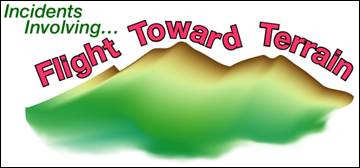 Analysis
of a recent controlled flight into terrain (CFIT) accident revealed that
the flight crew errors could be grouped into those that involved a failure
of group interaction skills, and those that involved individual errors
in thinking, planning, recognizing, preparing, or remembering (FSF Flight
Safety Digest, May-June 1998). An air carrier Check Airman's report to
ASRS provides examples of both error types -- even though the aircraft
involved was equipped with the latest terrain-avoidance technology:
Analysis
of a recent controlled flight into terrain (CFIT) accident revealed that
the flight crew errors could be grouped into those that involved a failure
of group interaction skills, and those that involved individual errors
in thinking, planning, recognizing, preparing, or remembering (FSF Flight
Safety Digest, May-June 1998). An air carrier Check Airman's report to
ASRS provides examples of both error types -- even though the aircraft
involved was equipped with the latest terrain-avoidance technology:
- Late night
training flight...We were going out [to] make a 180 degree turn and
land. The aircraft is equipped with an Enhanced Ground Proximity Warning
System [EGPWS]. It was on, and showed some terrain in the green band
at the 12 o'clock position. I vectored the student on a modified procedure
turn. I put my head down to get the VREF numbers and heard the ground
proximity warning, "Caution, terrain." I took over the controls
and performed our escape maneuver and gave the jet back to the student.
The student allowed the jet to descend again while my head was down.
Again the ground proximity [warning] went off. I did our escape maneuver
again and flew the airplane to the final approach course and let the
student land.
There were only 3 of us on board. Another student was in the jump
seat. I asked them if they saw the terrain on the enhanced display
and they said yes. They thought I would tell them when to turn. I
told them to fly the jet first regardless of who is in the left seat
(I'm a Check Airman). I should not have looked away while in that
phase of flight with new students unfamiliar with the area.
Enhanced GPWS is a second-generation
terrain avoidance system that is much prized by pilots. But it's no
substitute for proper training, clear communications among crew, and
a primary focus on flying the airplane.

The flight crew of a Turbo
Commander rediscovered a basic flying rule while trying to troubleshoot
a problem on an IFR approach over mountainous terrain. The First Officer
(the flying pilot) reports:
- After
passing the VOR, we were descended to 10,000 feet and given a vector
towards the final approach...We were traveling at approximately 230
knots. During this process the directional gyro on my side of the
cockpit failed and the Captain was trying to diagnose the problem.
At about this time, we were advised to descend and maintain 3,800
feet, which is the MVA [Minimum Vectoring Altitude] for that sector.
Our descent was delayed somewhat so we were descending fairly rapidly
while trying to diagnose the directional gyro problem and join the
localizer. Unfortunately, I failed to arrest the descent at 3,800
feet, and we were called by the Tower upon reaching approximately
3,300 feet [and] advised that the Tower was receiving a low altitude
alert. We were advised to climb immediately, which we did....
I am constantly preaching to everyone that rules 1 through 10 are
"fly the airplane first," and I simply failed to follow
my own rules. I should have...allowed the Captain to work out the
problems. Fortunately, [this airport] is an excellent ATC facility.
They quickly caught our altitude and gave us an immediate climb...Our
rate of descent was greater than 2,500 feet per minute which allowed
for very little deviation time.
Flight crew distraction is
a factor in many accidents. Our reporter's analysis is accurate. In
addition, pilots must be trained to recognize when they are rushed,
distracted, and susceptible to error.
 A
pilot practicing aerobatics over a private pasture learned why air show
performers don't attempt some maneuvers:
A
pilot practicing aerobatics over a private pasture learned why air show
performers don't attempt some maneuvers:
- I was
using a base of 1,500 feet AGL while I performed advanced aerobatic
maneuvers. I had worked all night the night before and was somewhat
tired. I had misjudged a couple of maneuvers...and realizing this,
added 200 feet to my base...I entered a hovering maneuver at 1,700
feet AGL. I pulled the nose up to a 60 degree or so angle with full
power and used the rudder to keep it straight...A popular air show
performer performs this maneuver and then rudders the aircraft in
a small turning circle to the right. I have done this maneuver many
times. This time, I decided to do a left-hand turn. There is a reason
the popular air show performer turns right. The aircraft suddenly
broke into a left-hand flat spin. I pulled the power, put in full
right rudder and released the stick...The rudder had no effectiveness.
I pushed the stick all the way forward which only resulted in a cross-over
spin to inverted. By this time, I was getting very low. It finally
came out of the spin at about a 45 degree inverted nose-down angle.
Due to my lack of altitude, I continued a delicate, buffeting 45 degree
push to level inverted. I only had 100-200 feet before I became a
statistic.
I figure that I lost 1,500 feet in only 4 rotations. Some botched
maneuvers require more than the 1,500 feet minimum mandated by the
FAA. That altitude is the bottom, and I need at least double that
for any new maneuvers. I am sure my lack of sleep affected my judgment,
and I feel that I am lucky to have survived....
We're also glad that our
reporter survived his ordeal and was willing to share this experience
with others.
Expectant
Pilots
The Pilot/Controller Glossary
defines an "Expect" altitude as one to be used in the event
of radio communications failure, and as information to assist a pilot
in planning. But some pilots take the information past the planning
stage, as a General Aviation reporter did:
- Our IFR
clearance was, "As filed, maintain 3,000 feet, expect 5,000 feet
within 10 minutes." Sometime after our frequency change to Departure
Control, we were cleared to climb to 5,000 feet. As we approached
5,000 feet, I asked the pilot-not-flying to request 7,000 feet. At
that point, ATC said he had cleared us to 4,000 feet -- not 5,000
feet. I had understood 5,000 feet, had written it down, and had set
the altitude alerter to 5,000 feet. The Controller told us to "just
stay at 5,000 feet and I'll work on a higher [altitude]." Perhaps
the fact that I had been expecting 5,000 feet within 10 minutes, per
the clearance received prior to takeoff, lured me into the error.
This report highlights the
importance of pilot readbacks in maintaining good pilot/controller communication.
It also points out how easily an "expect" instruction can
be interpreted as an actual instruction in the mind of an expectant
listener.
Another reporter, an air
carrier Captain, provided the necessary readback, but did not wait for
acknowledgment from the busy controller.
- At FL330,
I decided to ask for FL370 for fuel economy purposes and requested
such from Center. A clearance was received and read back, "Turn
left 15 degrees...maintain FL370." By then the Center Controller
was talking to another aircraft and did not acknowledge my readback.
Passing FL337, a TCAS II Traffic Advisory occurred. I reported this
to Center. The reply was, "You are supposed to be at FL330."
A descent to FL330 was done.
I called the Center [later] and listened to the tapes. The clearance
issued by the Controller was, "Turn left 15 degrees...maintain
FL330, expect FL370 when clear of traffic." Both pilots misheard
this, and my readback was made for a climb.
A pilot's best defense against
this sort of altitude deviation is to verify instructions before taking
any action. In this case, there was no obvious rush to start the enroute
climb.
 The
new rules governing Passenger Electronic Devices (PEDs) seem to have lessened
the frequency of PED-related reports to ASRS. But we still occasionally
hear about PEDs, including this unusual incident experienced by an air
carrier Captain:
The
new rules governing Passenger Electronic Devices (PEDs) seem to have lessened
the frequency of PED-related reports to ASRS. But we still occasionally
hear about PEDs, including this unusual incident experienced by an air
carrier Captain:
- While
at cruise, we experienced multiple spontaneous disconnects of the
left, center, and right autopilots over several hours of flight. After
due consideration of the sequence of disengagements, starting immediately
after I had authorized the use of PEDs...I made an announcement asking
that all PEDs be secured. All passengers complied. The anomaly continued.
I asked the lead Flight Attendant [FA] to make a more rigorous check
of the cabin. She reported that there was a passenger who had a significant
hearing impairment requiring that he use a hearing aid with headphones.
The microprocessor was carried in his shirt pocket. Without it, he
could not hear at all. Recalling...that PED interference is normally
very site-specific, I asked the FA to move the passenger forward...six
rows. No further interference occurred for the balance of the trip.
The only reason I did not have the passenger turn off his device was
my concern with his being able to hear and follow instructions from
the FAs in the event of an emergency. Also, since we had no further
instance of disengagement, and retained the option of securing the
device since we knew what the culprit was, I was very comfortable
with this course of action.
The Captain adds that an
extensive check of the autoflight system was performed later to confirm
that there was no mechanical anomaly.
GPS-timate
In another incident, a First
Officer reports that the suspected source of interference with his jet's
navigation system involved a passenger's "guessing game."
- Aircraft
equipped with IRS and FMC. Once airborne, I confirmed IRS/FMC nav
functions were working normally by using the fix page and raw data.
[During] the climb, both the Captain and myself noted the FMC was
not auto-updating itself. About this time we received a "verify
position" message from the FMC. The left and right IRS claimed
the actual position was 3.8 and 3.4 miles, respectively, 90 degrees
to our left. We were going to complete a position shift exercise,
when we noted we had auto-updating functions back and the FMC was
correcting itself. Later in the flight, a Flight Attendant called
and asked our ground speed. I told her it was 389 knots. She stated
she had lost a bet because a passenger had guessed 388 knots. I asked
her to ask the passenger if he had a GPS. The passenger said yes.
I asked her to tell the passenger to turn it off and keep it turned
off. The flight continued uneventfully. At deplaning, I found out
that the passenger was employed by another airline.


 Analysis
of a recent controlled flight into terrain (CFIT) accident revealed that
the flight crew errors could be grouped into those that involved a failure
of group interaction skills, and those that involved individual errors
in thinking, planning, recognizing, preparing, or remembering (FSF Flight
Safety Digest, May-June 1998). An air carrier Check Airman's report to
ASRS provides examples of both error types -- even though the aircraft
involved was equipped with the latest terrain-avoidance technology:
Analysis
of a recent controlled flight into terrain (CFIT) accident revealed that
the flight crew errors could be grouped into those that involved a failure
of group interaction skills, and those that involved individual errors
in thinking, planning, recognizing, preparing, or remembering (FSF Flight
Safety Digest, May-June 1998). An air carrier Check Airman's report to
ASRS provides examples of both error types -- even though the aircraft
involved was equipped with the latest terrain-avoidance technology:

 A
pilot practicing aerobatics over a private pasture learned why air show
performers don't attempt some maneuvers:
A
pilot practicing aerobatics over a private pasture learned why air show
performers don't attempt some maneuvers:
 The
new rules governing Passenger Electronic Devices (PEDs) seem to have lessened
the frequency of PED-related reports to ASRS. But we still occasionally
hear about PEDs, including this unusual incident experienced by an air
carrier Captain:
The
new rules governing Passenger Electronic Devices (PEDs) seem to have lessened
the frequency of PED-related reports to ASRS. But we still occasionally
hear about PEDs, including this unusual incident experienced by an air
carrier Captain: